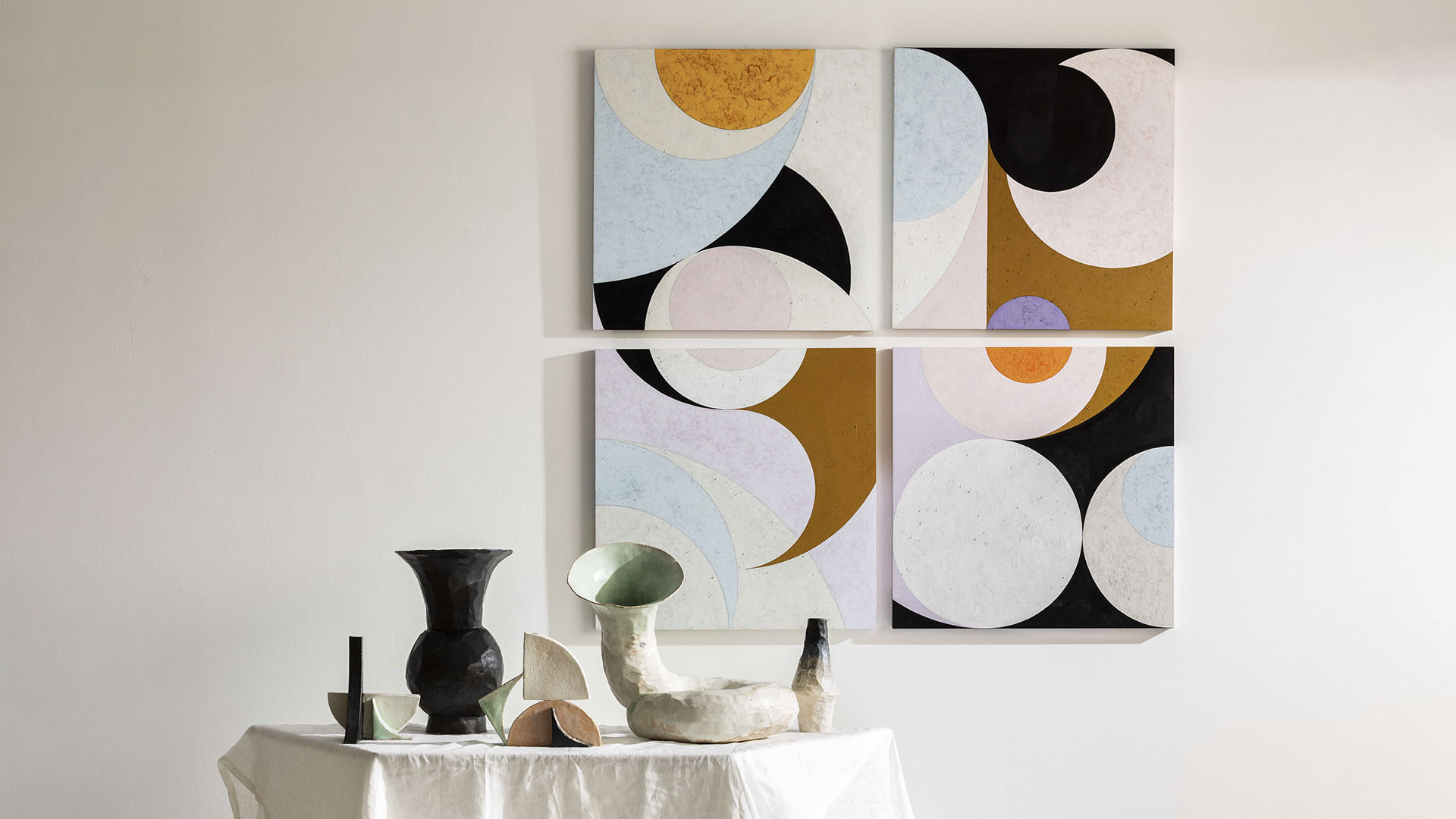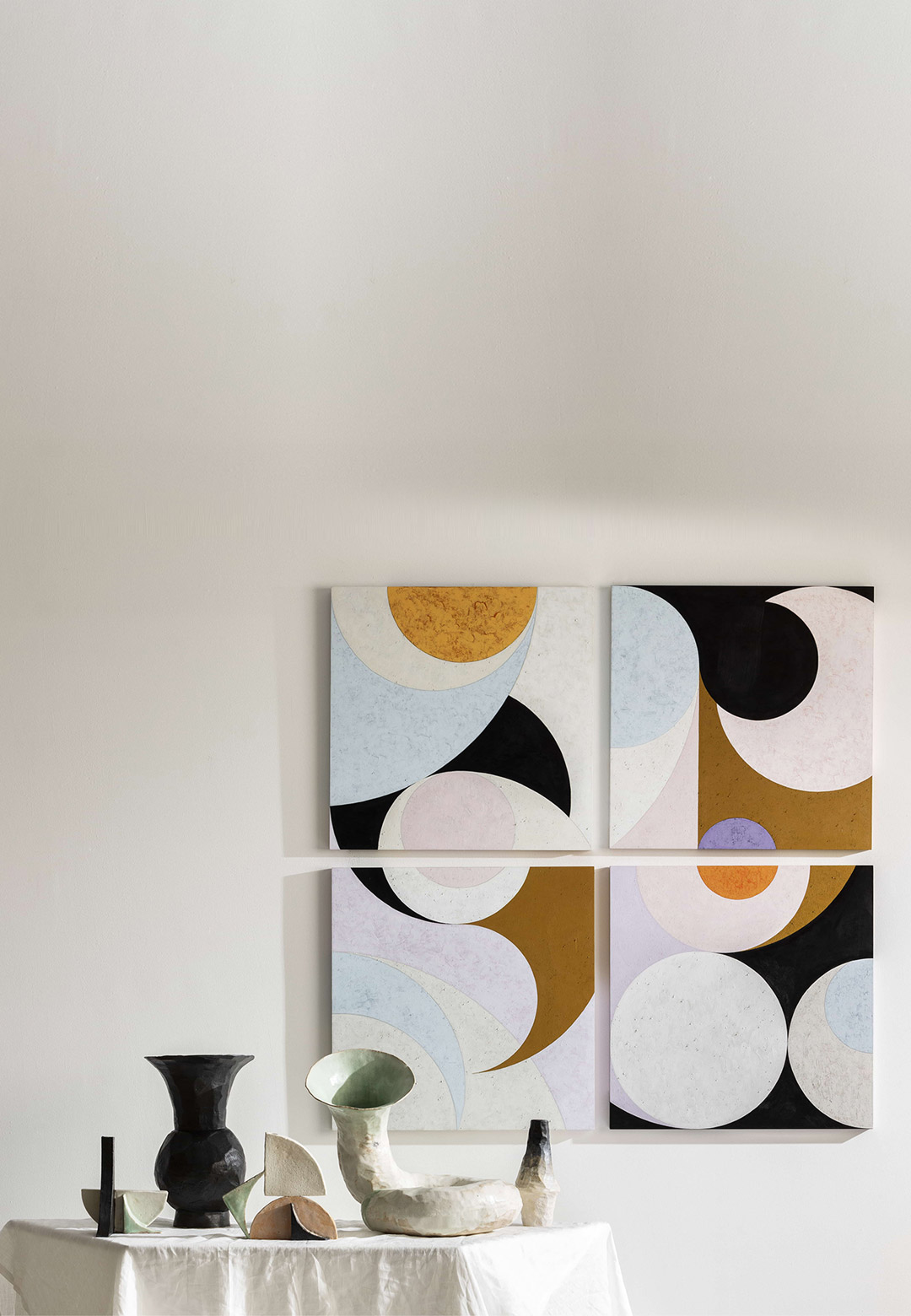Contrary to architectural constructions and design innovations, both of which emerge as a response to their context and the needs they cater to, artistic explorations primarily emerge in isolation. They are painted, cast, sculpted or chiselled in an attempt to recreate the artist’s imagination. These creations are unique and are designed to stand tall and hold their own against pallid backdrops. However, beyond design and art galleries and localised expositions, artworks often end up as parts of populous indoor spaces—paintings are hung next to tapestries and vases are decorated with half-blooming flowers in the midst of books, trophies or even perhaps decorative toys. This begets the question: should artistic endeavours not be collaborative, too? Should they not sometimes emerge in response to specified contexts, in order to fulfil the artistic shortcomings of the locale? And, in the absence of a pre-specified context, should artists not attempt to collaborate and interact with each other, as a creative exercise, in order to birth duets or even, perhaps, group artworks?
One such collaboration that was conducted by two Australian artists, Kirsten Perry and Bec Smith, is Interchange. Perry and Smith are friends, who, beyond their shared professions, are also dog lovers. This project is the culmination of years of discussion about their respective art practices. While Perry is a ceramic artist, Smith is a visual artist and freelance designer. A glimpse into their body of work reveals ascriptions to organic shapes and geometric patterns. Interchange, too, is a combination of the artists’ individualised approach to painting and shaping abstract shapes and forms, on canvas and in clay.
Both Perry and Smith reside in Melbourne, Australia. Looking back at the inceptive phase of this project, Smith shares, “On our project together, Kirsten nudged me onto a detour I needed, the title 'Interchange' is apt because from the beginning she encouraged me to play and explore without judgement, to cut and paste and see what comes. I was encouraged to use lo-fi materials such as cardboard to explore—the process was utterly refreshing.” Smith, who has previously worked to create abstract patterns and artworks that were inspired by the visual language of the Bauhaus movement, Modernism, Op Art, and Abstract Expressionism. For Interchange, she had a chance to move away from harmonious compositions and create pieces of art that are more dynamic and disconnected from rationality. However, all the individual paintings come together to create abstract, yet cohesive square and rectangular compositions on the wall.
Kirsten Perry’s ceramic works complement Smith’s abstract paintings. While most of Perry’s previous works in ceramic embodied an organic form and were coloured in pared-down shades, her Interchange pieces are characterised by abstract forms and pastel shades, perhaps as an influence from Smith’s vibrant artworks. Regarding her collaboration with Smith, Perry shares, “Twists and turns you would not necessarily accept. Connections made and explored, an exchange that is mutually attractive. An interchange must have some common characteristics, a compatibility, but also enough difference that creates a little miracle.”
Over the years, the two artists have spent time exploring and understanding each other’s style and method of creating. Their friendship has helped the two creatives gain an understanding of each other’s oeuvre on a more intimate level. While Smith draws references for her designs from her day-to-day experiences, interactions and observations, Perry utilises the plaster mould making process to shape slip cast and press moulded ceramic forms. The texture of her ceramic works bear the imprints of her gestural handmade process. For their Interchange project, both Smith and Perry influenced each other to give way to a final style, defined by subtle hues and geometric shapes and forms.
Describing the works that form part of Interchange, Perry shares, “This work is composed of modular units that can be arranged in various forms. Like building blocks, train sets, pipe works, the units have a playful tone that build a narrative. The texture of the objects shows evidence of my hand and the soft glaze colour palette, additionally reaches gently out to the colours and shapes in Bec’s paintings.” Perry’s Pipe Dream is her largest work to date. Reminiscing back on the making of this piece, Perry shares, “I am restricted with ceramics that fit into my kiln, so designing a piece made of modular units was the only way to make a large work. Any larger works are more prone to warping in the kiln. The piece relies on a female and male stacking system so there was a bit of rearranging and grinding back to allow them to all fit together. It’s actually more suited to being installed outdoors as you can hammer a metal rod into the ground to add stability and then silicone the pieces together.”
Kirsten Perry is a creative who builds biomorphic ceramic art vessels—both functional and decorative—that serve as a homage to the traditional craft of sculpting ceramics. Her ceramic moulds are shaped using disposable materials such as foam and cardboard, which are then cast in plaster and allowed to dry. Clay is then poured into this mould and removed at the appropriate time to conjoin it with other elements and forms as part of the larger composed sculpture. The final pieces are then dried in bisque fire and glazed. In Perry’s creations, one ends up pondering more on the external texture as opposed to the final forms of these vessels. In letting the flaws and vulnerabilities of the ceramic objects shine through her objects, Perry ascribes authenticity and rawness to them.
Listing her influences in Franz West, Isamu Noguchi, JB Blunk and Louise Bourgeois, Perry shares, “Franz’s work is so lyrical and playful, it makes my heart soar with joy. Isamu has a quiet reverence for beauty that can knock you over with a feather. Blunk has a connection with nature that makes you want to go live in the woods and befriend all the animals, and Louise has an inherent femininity that is both humble and profound.”
As a ceramic artist, Perry is attracted to materials and the visual and tactile qualities they embody. Since clay can evenly mimic the materialities of various different objects, just by the usage of an appropriate mould and moulding technique, Perry imprints her artistic impressions on this versatile material. Sharing some of her favourite textures, Perry says, “I like humble materials such as paper and foam. Paper has the tensile strength that folds and can hold with just a thin layer. Polystyrene is made up of tiny spheres that stick together with little gaps of air in between and when cut, can show this texture.”
Her final ceramic sculptures are conjoined in disbalanced compositions. A contrast of size, shape and texture imbues the pieces with a dynamic personality. “I like to play with forms that strike an unexpected balance with either size, shape, texture or repetition. My process allows me to have many forms and then bring together partnerships. Sculptures can change when you view them at different angles, encouraging the viewer to build a relationship with the work,” Perry shares.
On being asked when, where and how ideas strike, Perry shares, “Sometimes an idea comes to me as I am falling asleep. Sometimes a shape is where it starts, or it comes from just playing with things in the studio. I could be folding paper, see another form in an older work that needs refining, or be inspired by a form in nature. In the past I used to rush into ideas but now I am taking things a bit slower and sketching an idea before I start. If I carve a form in foam, I like to place it on my sideboard and study it for a few days to see if it is ‘right’.My work has an inconsistency and imperfection to it, but it has to be the ‘right’ inconsistency and imperfection for me to be happy with it. I like to leave room in the process for mistakes and serendipity to take me to unexpected places, otherwise, life would be too boring, huh?”
Beyond Interchange, Perry intends to explore her craft in an overseas ceramics residency, while also dreaming of setting up a shop-cum-studio for her ceramic works and her more recently developed love for tropical houseplants.






 Sign in with email
Sign in with email










What do you think?